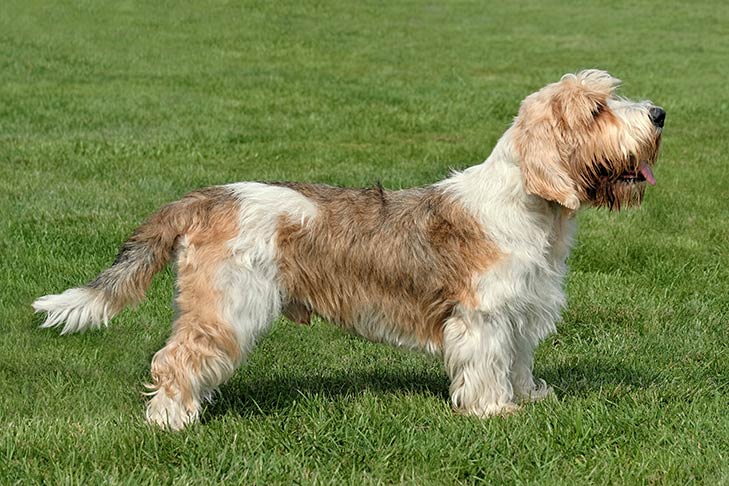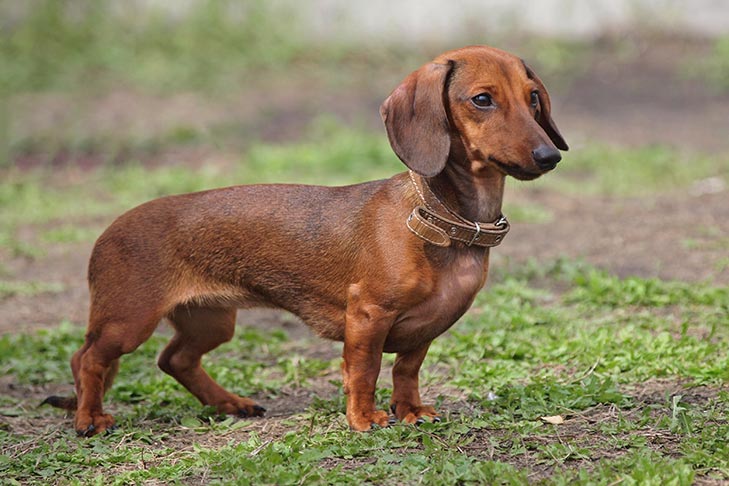Short limbs and an unusually large head are signs of a medical condition called dwarfism in dogs. Dwarfism encompasses several conditions, and dogs with dwarfism can have affected size, health, and development. These conditions are hereditary, meaning they can pass from parents to offspring through genes. In this case, only one parent needs to have the gene for their offspring to inherit dwarfism.
Some dogs are purposefully bred to have features like short legs. Just think of the Dachshund or Pembroke Welsh Corgi. In other instances, a genetic mutation that results in abnormal growth of bones and cartilage can cause dwarfism, leading to short stature and physical deformities. Learn about the different forms of dwarfism in dogs, how they’re diagnosed, and which breeds are commonly affected.

What Is Dwarfism?
Dwarfism is a medical condition that affects people and dogs. A dog with dwarfism has “abnormally short stature and disproportionate body proportions,” according to Dr. Amy Attas, VMD of New York-based practice City Pets. Dwarfism is caused by genetic mutations that affect the development of a dog’s skeletal system, which are the bones that make up the body and protect their internal organs. Two common forms of dwarfism are achondroplasia and pituitary dwarfism.
Achondroplasia
“The most common form of dwarfism in dogs is called achondroplasia,” Dr. Attas says. Achondroplasia is caused by a genetic mutation that affects the fibroblast growth factor receptors, which are involved in regulating bone growth. This mutation inhibits cartilage from hardening into bone, which normally occurs during fetal development, she adds.
As a result, dogs are born with shortened or bowed limbs or an abnormally large head. We recognize these features as standard in certain breeds because we’ve selected for this gene mutation during the breeding process. These breeds include the Dachshund, Basset Hound, Pembroke Welsh Corgi, Bulldog, French Bulldog, and Petit Basset Griffon Vendéen.
Pituitary Dwarfism
Pituitary dwarfism in dogs isn’t the result of selective breeding. In fact, you should avoid breeding dogs with this condition. Also called hypopituitarism, pituitary dwarfism occurs when the pituitary gland doesn’t produce or secrete enough growth hormone, Dr. Attas explains. The pituitary gland produces hormones that regulate metabolism, growth, and reproduction.
There are several causes of pituitary dwarfism in dogs, including genetic mutations. These mutations, if present, would affect an individual dog rather than the entire breed. For example, you can have a litter of puppies and only one with this genetic mutation.

Pituitary dwarfism can also occur because of damage to the pituitary gland during the birthing process. A lack of oxygen can affect the gland’s ability to produce growth hormone. Other causes of pituitary dwarfism are tumors, inflammatory conditions, and traumatic brain injury early in life, but these are pretty rare, she says.
Pituitary dwarfism is most commonly seen in the German Shepherd Dog. “These dogs look like miniature German Shepherd Dogs,” explains Dr. Attas. “It doesn’t seem to affect their ears, so they have these big ears, small bodies, and coats with missing fur.” You may also see this genetic mutation in the Tibetan Terrier, as well as breeds more commonly found outside of the U.S., such as the White Swiss Shepherd Dog and Lapponian Herder. Although rare, there have been reports of pituitary dwarfism in the following breeds:
- Weimaraner
- Finnish Spitz
- Miniature Pinscher
- Karelian Bear Dog
- Golden Retriever
- Labrador Retriever
- Rottweiler
What Are Symptoms of Dwarfism in Dogs?
A dog with pituitary dwarfism may be considerably smaller than the so-called “runt” of the litter. Because of a hormone deficiency, they tend to have various health issues such as:
- Adult teeth taking longer to erupt
- Abnormal bite alignment and dental problems
- Thin and fragile coats with hairs that break easily
- Alopecia or patches of hairlessness
- Skin problems
- Susceptibility to infection
- Decreased muscle mass
- Hip dysplasia
- Luxating patella
- Eye problems, such as cataracts and retinal degeneration
These dogs are often infertile. “[This] is a good thing because we would never want these dogs to reproduce,” notes Dr. Attas. “I want to stress that pituitary dwarfism is a pretty rare condition.” If you’re planning to get a German Shepherd Dog or another one of the affected breeds, you may wish to ask if there’s any history of dwarfism in the line.

How Is Dwarfism Diagnosed in Dogs?
If a puppy is much smaller than their littermates, there are ways to confirm whether they have pituitary dwarfism. “When you x-ray these dogs, you would expect to find decreased ossification (i.e., hardening of cartilage) of their bones,” Dr. Attas says. The vet can run tests to identify genetic mutations or do a blood test to measure hormone levels.
A dog with dwarfism will have lower growth hormone levels compared to their littermates. You can supplement with growth hormone, but there is no commercially available product for dogs, according to Dr. Attas. Human growth hormone isn’t an option because dogs develop antibodies against these supplements. The best option is “pig growth hormone, which is commercially available and seems to work in dogs,” she says.
The vet will also look at creatinine levels, which are often elevated in dogs with pituitary dwarfism. Creatinine is a normal waste product in blood and urine and indicates how well the kidneys are functioning. Plus, it’s helpful if the puppy has littermates against which you can compare results.
Another sign of pituitary dwarfism is hypothyroidism, which occurs when the thyroid gland doesn’t make enough hormones for the body to properly function. You can measure a dog’s thyroid level and use medication to treat an underactive thyroid gland.
How Do You Manage Symptoms of Dwarfism in Dogs?
With achondroplastic dogs, even though we select for these traits, “we are predisposing them to have medical issues including back, disc, and spinal cord problems,” Dr. Attas says. These dogs have bodies that are long and low to the ground, which puts a lot of pressure on their backs.

Since dogs are born with pituitary dwarfism, surgery or physical rehabilitation cannot correct this condition. “These dogs are always going to have issues [and] are never going to achieve a normal size,” says Dr. Attas. Once you’ve confirmed that a dog has this form of dwarfism, you can give them porcine growth hormone and treat their thyroid deficiency with hormone replacement therapy.
Dogs are more likely to develop disc problems when they’re overweight. “These disc problems are painful and sometimes become emergencies if the disc compresses the spinal cord,” she says. “If this happens, surgery needs to be done quickly, or dogs can lose their ability to walk.” As with many health conditions, it’s wise to keep your dog at a healthy weight through proper diet and exercise.
Because pituitary dwarfism is due to a genetic mutation, “we’re not going to fix this problem,” she says. “The reason for doing health testing is if the dog comes from a kennel which plans on doing continued breeding.” If this mutation is present, you would mark the dam and sire accordingly and avoid breeding them. The vet may also recommend spaying or neutering the dog as a precaution.
The post What to Know About Dwarfism in Dogs appeared first on American Kennel Club.



0 Comments
Recommended Comments
There are no comments to display.